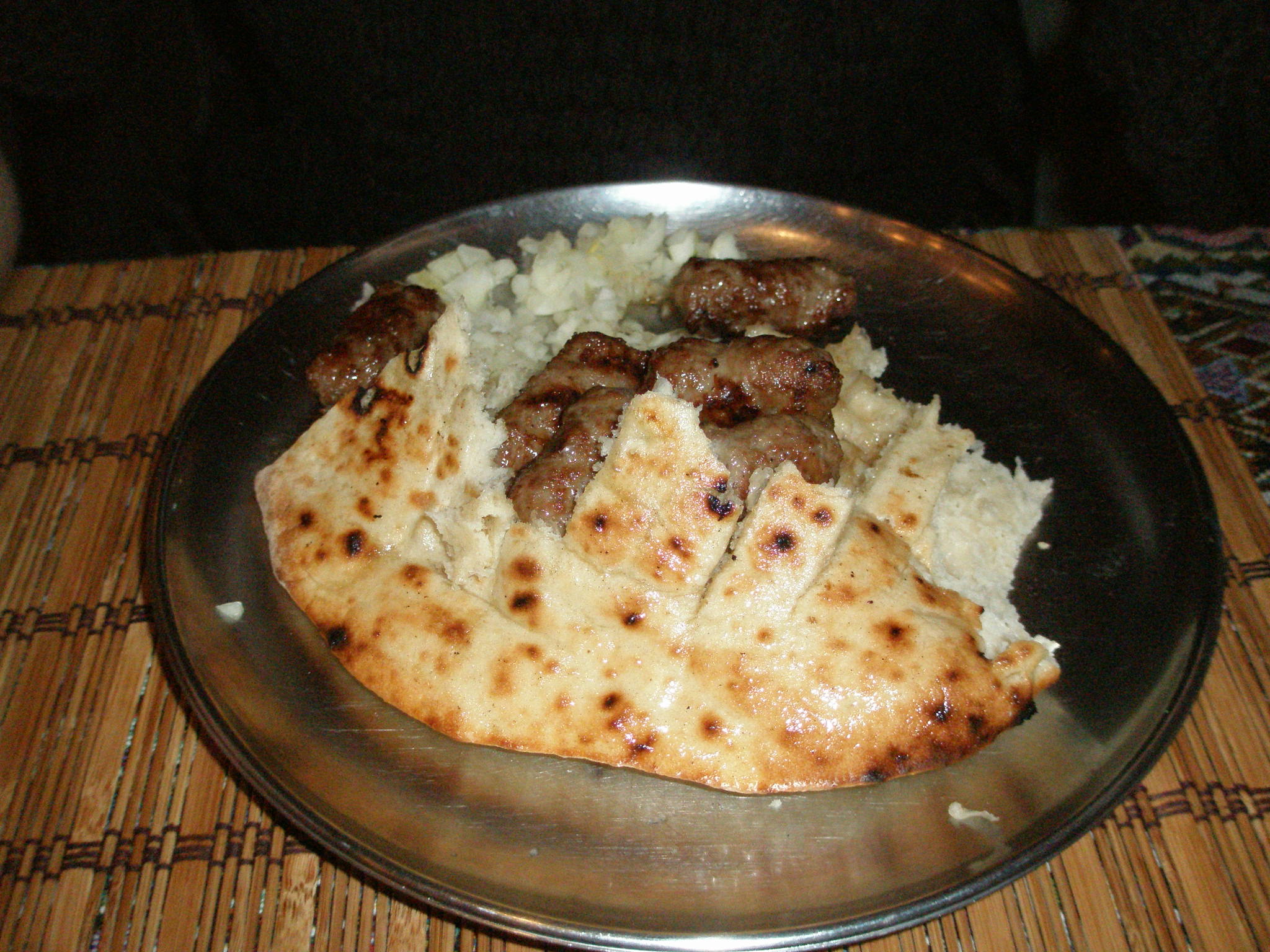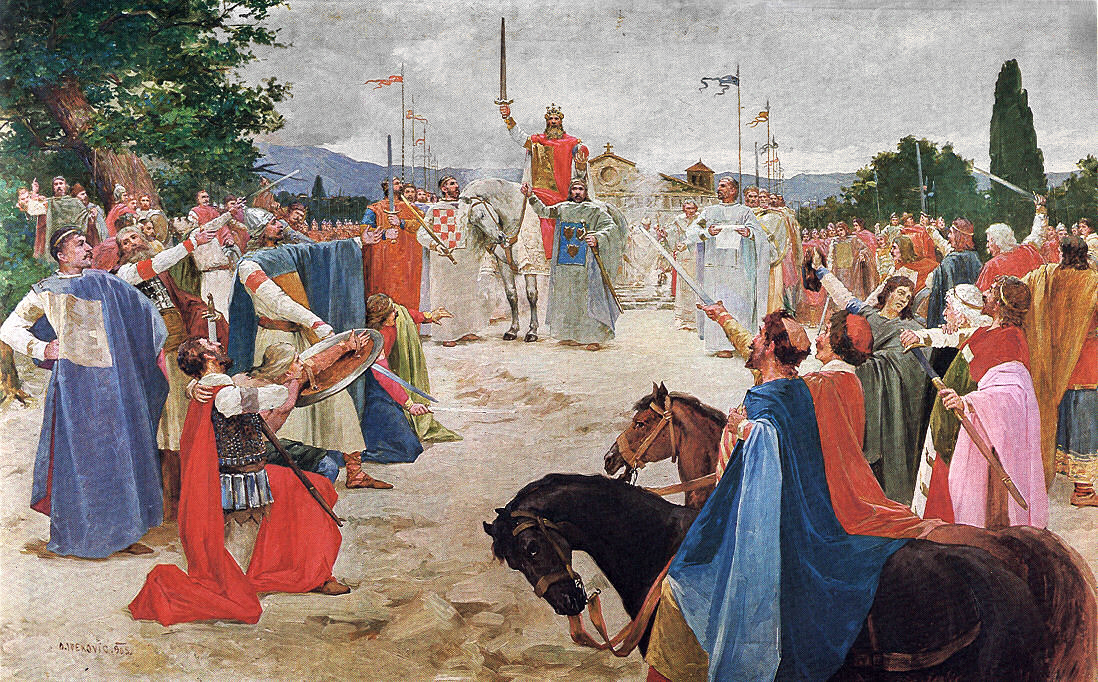|
Cuisine Of Bosnia And Herzegovina
Bosnia and Herzegovina cuisine ( bs, Bosanska kuhinja) is balanced between Western and Eastern influences. The food is closely related to former Yugoslav, Middle Eastern, Mediterranean, Austo-Hungarian and other Balkan cuisines. Ingredients Bosnian cuisine uses many spices, but usually in moderate quantities. Most dishes are light, as they are cooked in lots of water; the sauces are fully natural, consisting of little more than the natural juices of the vegetables in the dish. Typical ingredients include tomatoes, potatoes, onions, garlic, bell peppers, cucumbers, carrots, cabbage, mushrooms, spinach, courgette, dried and fresh beans, plums, milk, paprika and cream called pavlaka and kajmak. Typical meat dishes include primarily beef and lamb due to Islamic dietary laws, although the Bosnian Croats and Bosnian Serbs can consume pork. Some local specialties are ćevapi, burek, dolma, sarma, ''pilav'' ( pilaf), ''gulaš'' (goulash), ajvar and a whole range of Eastern ... [...More Info...] [...Related Items...] OR: [Wikipedia] [Google] [Baidu] |
Bosnia And Herzegovina
Bosnia and Herzegovina ( sh, / , ), abbreviated BiH () or B&H, sometimes called Bosnia–Herzegovina and often known informally as Bosnia, is a country at the crossroads of south and southeast Europe, located in the Balkans. Bosnia and Herzegovina borders Serbia to the east, Montenegro to the southeast, and Croatia to the north and southwest. In the south it has a narrow coast on the Adriatic Sea within the Mediterranean, which is about long and surrounds the town of Neum. Bosnia, which is the inland region of the country, has a moderate continental climate with hot summers and cold, snowy winters. In the central and eastern regions of the country, the geography is mountainous, in the northwest it is moderately hilly, and in the northeast it is predominantly flat. Herzegovina, which is the smaller, southern region of the country, has a Mediterranean climate and is mostly mountainous. Sarajevo is the capital and the largest city of the country followed by Banja Luka, Tu ... [...More Info...] [...Related Items...] OR: [Wikipedia] [Google] [Baidu] |
Spinach
Spinach (''Spinacia oleracea'') is a leafy green flowering plant native to central and western Asia. It is of the order Caryophyllales, family Amaranthaceae, subfamily Chenopodioideae. Its leaves are a common edible vegetable consumed either fresh, or after storage using preservation techniques by canning, freezing, or dehydration. It may be eaten cooked or raw, and the taste differs considerably; the high oxalate content may be reduced by steaming. It is an annual plant (rarely biennial), growing as tall as . Spinach may overwinter in temperate regions. The leaves are alternate, simple, ovate to triangular, and very variable in size: long and broad, with larger leaves at the base of the plant and small leaves higher on the flowering stem. The flowers are inconspicuous, yellow-green, in diameter, and mature into a small, hard, dry, lumpy fruit cluster across containing several seeds. In 2018, world production of spinach was 26.3 million tonnes, with China alone accounti ... [...More Info...] [...Related Items...] OR: [Wikipedia] [Google] [Baidu] |
Dolma
Dolma (Turkish for “stuffed”) is a family of stuffed dishes associated with Ottoman cuisine, and common in modern national cuisines of regions and countries that once were part of the Ottoman Empire. Some types of dolma are made with whole vegetables, fruit, offal or seafood, while others are made by wrapping grape, cabbage, or other leaves around the filling. Wrapped dolma are known as '' sarma''. They can be served warm or at room temperature. History Stuffed vegetable dishes have been a part of Middle Eastern cuisine for centuries. Recipes for stuffed eggplant have been found in Medieval Arabic cookbooks and, in Ancient Greek cuisine, fig leaves stuffed with sweetened cheese were called . The word dolma, of Turkish origin, means "something stuffed" or "filled". (Turkish taxis are called ''dolmuş'' for similar reasons). In some of the former Ottoman countries, native names have been retained or have blended with Turkish language terms, for example, in the Arab states ... [...More Info...] [...Related Items...] OR: [Wikipedia] [Google] [Baidu] |
ćevapi
Ćevapi (, ), ćevapčići (formal: diminutive; , ) is a grilled dish of minced meat found traditionally in the countries of southeast Europe (the Balkans). It is considered a national dish of Serbia and Bosnia and Herzegovina, and is also common in Croatia, Montenegro, Kosovo, North Macedonia and Slovenia. Ćevapi has its origins in the Balkans during the Ottoman period, and represents a regional speciality similar to the köfte kebab. They are usually served in groups of five to ten pieces on a plate or in a flatbread (''lepina'' or ''somun''), often with chopped onions, sour cream, kajmak (milk cream), ajvar (relish), and salt. Bosnian ćevapi are made from two types of minced beef meat, hand-mixed and formed with a funnel, while formed ćevapi are grilled. Serbian ćevapčići are made of beef, lamb or pork, or a mixture. Name and etymology The word ''ćevap'' is derived from the Turkish ''kebab''. The word is sometimes used in conjunction with the common South Slavi ... [...More Info...] [...Related Items...] OR: [Wikipedia] [Google] [Baidu] |
Bosnian Serbs
The Serbs of Bosnia and Herzegovina ( sr-Cyrl, Срби у Босни и Херцеговини, Srbi u Bosni i Hercegovini) are one of the three constitutive nations (state-forming nations) of the country, predominantly residing in the political-territorial entity of Republika Srpska. In the other entity, Federation of Bosnia and Herzegovina, Serbs form the majority in Drvar, Glamoč, Bosansko Grahovo and Bosanski Petrovac. They are frequently referred to as Bosnian Serbs ( sr, босански Срби, Bosanski Srbi) in English, regardless of whether they are from Bosnia or Herzegovina. They are also known by regional names such as ''Krajišnici'' ("frontiersmen" of Bosanska Krajina), ''Semberci'' ( Semberians), ''Bosanci'' (Bosnians), ''Birčani'' (''Bircians''), Romanijci (''Romanijans''), ''Posavci'' (Posavians), ''Hercegovci'' (Herzegovinians). Serbs have a long and continuous history of inhabiting the present-day territory of Bosnia and Herzegovina, and a long history ... [...More Info...] [...Related Items...] OR: [Wikipedia] [Google] [Baidu] |
Bosnian Croats
The Croats of Bosnia and Herzegovina (), often referred to as Bosnian Croats () or Herzegovinian Croats () are the third most populous ethnic group in the country after Bosniaks and Serbs, and are one of the constitutive nations of Bosnia and Herzegovina. Croats of Bosnia and Herzegovina have made significant contributions to the culture of Bosnia and Herzegovina. Most Croats declare themselves Catholics and speakers of Croatian language. From the 15th to the 19th century, Catholics in Ottoman Bosnia and Herzegovina were often persecuted by the Ottoman Empire, causing many of them to flee the area. In the 20th century, political turmoil and poor economic conditions caused more to emigrate. Ethnic cleansing within Bosnia and Herzegovina in the 1990s saw Croats forced to go to different parts of Bosnia and Herzegovina, despite having lived in numerous regions prior to the Bosnian War. The 2013 population census in Bosnia and Herzegovina recorded 544,780 residents registering as ... [...More Info...] [...Related Items...] OR: [Wikipedia] [Google] [Baidu] |
Islamic Dietary Laws
Islamic dietary laws are dietary laws that Muslims follow. Islamic jurisprudence specifies which foods are '' '' (, "lawful") and which are '' '' (, "unlawful"). The dietary laws are found in the Quran, the holy book of Islam, as well as in collections of traditions attributed to Islamic prophet Muhammad. Herbivores or cud-chewing animals like cattle, deer, sheep, goats, and antelope are some examples of animals that are halal only if they are treated like sentient beings and slaughtered painlessly while reciting the Bismillah and Takbir. If the animal is treated poorly, or tortured while being slaughtered, the meat is haram. Forbidden food substances include alcohol, pork, carrion, the meat of carnivores and animals that died due to illness, injury, stunning, poisoning, or slaughtering not in the name of God. Regulations of food Halal (permissible, lawful) Quranic verses which have information regarding halal foods include: Q2:173, Q5:5, and Q6:118–119, 121. Permissible ... [...More Info...] [...Related Items...] OR: [Wikipedia] [Google] [Baidu] |
Lamb And Mutton
Lamb, hogget, and mutton, generically sheep meat, are the meat of domestic sheep, ''Ovis aries''. A sheep in its first year is a lamb and its meat is also lamb. The meat from sheep in their second year is hogget. Older sheep meat is mutton. Generally, "hogget" and "sheep meat" are not used by consumers outside Norway, New Zealand, South Africa, Scotland and Australia. Hogget has become more common in England, particularly in the North (Lancashire and Yorkshire) often in association with rare breed and organic farming. In South Asian and Caribbean cuisine, "mutton" often means goat meat.''Oxford English Dictionary'', 3rd edition, June 2003''s.v.'',_definition_1b_At_various_times_and_places,_"mutton"_or_"goat_mutton"_has_occasionally_been_used_to_mean_goat_meat. Lamb_is_the_most_expensive_of_the_three_types_and_in_recent_decades_sheep_meat_is_increasingly_only_retailed_as_"lamb",_sometimes_stretching_the_accepted_distinctions_given_above._The_stronger-tasting_mutton_is_now_hard ... [...More Info...] [...Related Items...] OR: [Wikipedia] [Google] [Baidu] |
Kaymak
Kaymak, sarshir, or qashta/ashta ( fa, سَرشیر ) ( ar, قشطة or ar, قيمر ) is a creamy dairy food similar to clotted cream, made from the milk of water buffalo, cows, sheep, or goats in Central Asia, some Balkan countries, some Caucasus countries, the countries of the Levant, Turkic regions, Iran and Iraq. In Poland, the name refers to a confection similar to dulce de leche instead. The traditional method of making kaymak is to boil the raw milk slowly, then simmer it for two hours over a very low heat. After the heat source is shut off, the cream is skimmed and left to chill (and mildly ferment) for several hours or days. Kaymak has a high percentage of milk fat, typically about 60%. It has a thick, creamy consistency (not entirely compact, because of milk protein fibers) and a rich taste. Etymology The word ''kaymak'' has Central Asian Turkic origins, possibly formed from the verb , which means 'melt' and 'molding of metal' in Turkic. The first written re ... [...More Info...] [...Related Items...] OR: [Wikipedia] [Google] [Baidu] |
Paprika
Paprika ( US , ; UK , ) is a spice made from dried and ground red peppers. It is traditionally made from ''Capsicum annuum'' varietals in the Longum group, which also includes chili peppers, but the peppers used for paprika tend to be milder and have thinner flesh. In some languages, but not English, the word ''paprika'' also refers to the plant and the fruit from which the spice is made, as well as to peppers in the Grossum group (e.g. bell peppers). All capsicum varieties are descended from wild ancestors in North America, in particular Central Mexico, where they have been cultivated for centuries. The peppers were subsequently introduced to the Old World, when peppers were brought to Spain in the 16th century. The seasoning is used to add color and flavor to many types of dishes in diverse cuisines. The trade in paprika expanded from the Iberian Peninsula to Africa and Asia and ultimately reached Central Europe through the Balkans, which was then under Ottoman rule. This he ... [...More Info...] [...Related Items...] OR: [Wikipedia] [Google] [Baidu] |




.jpg)

